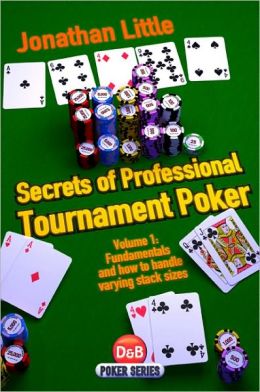 I reviewed Volume 2 of Jonathan Little’s Secrets of Professional Tournament Poker before reading Volume 1, because that’s the order his publisher happened to sent them to me. Although I didn’t much care for the second volume, I held out hope that the first could be better. Unfortunately, even though it’s much more centered on actual poker strategy, it suffers from many of the same weaknesses.
I reviewed Volume 2 of Jonathan Little’s Secrets of Professional Tournament Poker before reading Volume 1, because that’s the order his publisher happened to sent them to me. Although I didn’t much care for the second volume, I held out hope that the first could be better. Unfortunately, even though it’s much more centered on actual poker strategy, it suffers from many of the same weaknesses.
Secrets of Professional Tournament Poker Volume 1 is a dangerous book because it has the potential to lull inexperienced readers into a false sense of understanding. Only the simplest of concepts are explained in clear and straightforward fashion, with Little blithely advising readers to use their judgment whenever things get complicated. Help with these tricky judgment calls is of course what all but the most inexperienced players will be looking for in a poker book. For example, “If called, you should make a continuation bet on every flop, as you are representing a strong hand by re-raising pre-flop. Again, do not go overboard with these plays or they will become unprofitable.” So, continuation bet every time, but don’t go overboard with it?
Despite a one-page section entitled “Do Not Play Robotically”, Little makes heavy use of the word “standard”. Continuation bets are “standard”, bet sizes are “standard”, and sometimes even other players are “standard”. Again, these concepts may actually have some meaning for experienced players, but I don’t see them being helpful to the people most likely to read this book. At worst, they entrench the idea that certain extremely exploitable tendencies such as continuation betting every time are fundamentally sound play rather than an exploitable adaptation to a particular metagame.
Secrets is not a book that will age well, because Little makes a lot of assumptions about what certain actions by an opponent are likely to mean. For example, “people usually have a monster when they min-re-raise” or “most opponents won’t even try to bluff the river when you show two streets of aggression.” Even if these are accurate depictions of the current metagame, Little does not present them with that caveat, and there’s no reason why they would have to be true five years in the future.
When discussing continuation bets, Little suggests betting everything except medium-strength hands such as top pair with a weak kicker. With these, he advises checking and then calling turn and river bets “as your hand is underrepresented”. These days, there are plenty of players who will correctly guess exactly what you have once you take this line, enabling them to put you to tough decisions on the turn and river.
Most problematically, Little makes seemingly logical arguments for downright incorrect statements. He claims that, “any hand can conceivably be raised from any position, especially with deep stacks.” This is a common misunderstanding among tournament players who are unaccustomed to playing against good, deep-stacked opponents, but the insinuation is incorrect. The deeper you are, the fewer hands you can play profitable from early position when the players on your left understand how to exercise their positional advantage.
The worst offender is in a section entitled “Make Your Decisions Simple”. Little suggests that if you are going to have a close fold if someone shoves over your open raise, then you should raise a little bigger, because “if you raise more, you will be getting better odds so you can call.” It makes sense unless you think about it, which many readers won’t be equipped to do. All you’re really doing is denying yourself the opportunity to make a good fold by artificially pricing yourself in. By this logic, you should just raise half your stack every time you open, then you’ll always be priced in to call a shove. Easy game!
Of course, not everything in Secrets of Professional Tournament Poker Volume 1 is underexplained or misleading. The problem is that more than a bit of it is, and unless you already know enough about poker to know what to disregard, then you’re going to take in a lot of unhelpful or downright wrong information without realizing it. I could see this book being responsible for a lot of bad habits – in fact, I think I actually have had students come to me with bad habits caused or reinforced by it. It’s too bad, because a player of Little’s caliber ought to be able to write a really good tournament book, but this is not it.
